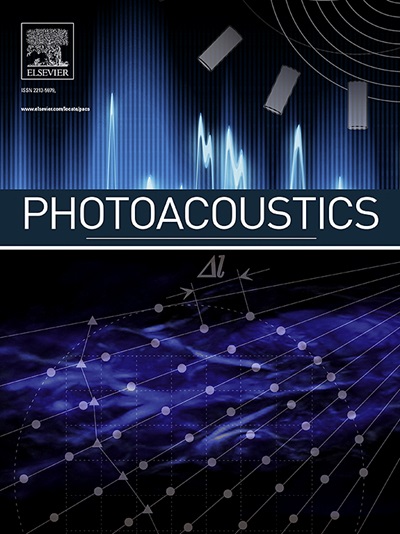用于高灵敏度痕量乙炔传感的三维光路扩展葫芦型光声电池
IF 6.8
1区 医学
Q1 ENGINEERING, BIOMEDICAL
引用次数: 0
摘要
一种新型的葫芦型光声电池(GTPAC)已经开发出来,其特点是高反射,抛光的金膜涂层内壁,最大限度地减少了光损失,最大限度地提高了光利用效率。GTPAC集成了两个耦合的球室,半径比为2:3,接近黄金分割。其独特的高斯曲率分布使多向,无序光束反射无需复杂的光学校准。它创造了一个非周期性的三维(3D)光学轨迹,显著增强了光分子的相互作用。GTPAC采用中心波长为1532 nm(±1.5 nm)的分布式反馈蝶形激光器检测乙炔气体,灵敏度高达3.36 μV/ppm。当积分时间延长到100 s时,最小检出限低至0.59 ppb。此外,其灵活的设计和广谱兼容性使其具有扩展到其他气体(如甲烷和氮氧化物)的巨大潜力,为超灵敏微量气体检测提供了新的前景。本文章由计算机程序翻译,如有差异,请以英文原文为准。
Three-dimensional optical path extended gourd-type photoacoustic cell for highly sensitive trace acetylene sensing
A novel gourd-type photoacoustic cell (GTPAC) has been developed, featuring a highly reflective, polished gold film-coated inner wall that minimizes optical loss and maximizes light utilization efficiency. GTPAC integrates two coupled spherical chambers with a radius ratio 2:3, which is close to the golden ratio. Its unique Gaussian curvature distribution enables multi-directional, disordered light beam reflection without complex optical alignment. It creates a non-periodic three-dimensional (3D) optical trajectory, significantly enhancing light-molecule interactions. GTPAC achieves an exceptionally high sensitivity of up to 3.36 μV/ppm using a distributed feedback butterfly laser with central wavelength of 1532 nm (±1.5 nm) to detect acetylene gas. When the integration time is extended to 100 s, the minimum detection limit is as low as 0.59 ppb. Moreover, its flexible design and broad spectral compatibility enable significant potential for extension to other gases, such as methane and nitrogen oxides, offering new prospects for ultra-sensitive trace gas detection.
求助全文
通过发布文献求助,成功后即可免费获取论文全文。
去求助
来源期刊

Photoacoustics
Physics and Astronomy-Atomic and Molecular Physics, and Optics
CiteScore
11.40
自引率
16.50%
发文量
96
审稿时长
53 days
期刊介绍:
The open access Photoacoustics journal (PACS) aims to publish original research and review contributions in the field of photoacoustics-optoacoustics-thermoacoustics. This field utilizes acoustical and ultrasonic phenomena excited by electromagnetic radiation for the detection, visualization, and characterization of various materials and biological tissues, including living organisms.
Recent advancements in laser technologies, ultrasound detection approaches, inverse theory, and fast reconstruction algorithms have greatly supported the rapid progress in this field. The unique contrast provided by molecular absorption in photoacoustic-optoacoustic-thermoacoustic methods has allowed for addressing unmet biological and medical needs such as pre-clinical research, clinical imaging of vasculature, tissue and disease physiology, drug efficacy, surgery guidance, and therapy monitoring.
Applications of this field encompass a wide range of medical imaging and sensing applications, including cancer, vascular diseases, brain neurophysiology, ophthalmology, and diabetes. Moreover, photoacoustics-optoacoustics-thermoacoustics is a multidisciplinary field, with contributions from chemistry and nanotechnology, where novel materials such as biodegradable nanoparticles, organic dyes, targeted agents, theranostic probes, and genetically expressed markers are being actively developed.
These advanced materials have significantly improved the signal-to-noise ratio and tissue contrast in photoacoustic methods.
 求助内容:
求助内容: 应助结果提醒方式:
应助结果提醒方式:


